463 Search Results for autism
February 28, 2018
by Carole Zangari -
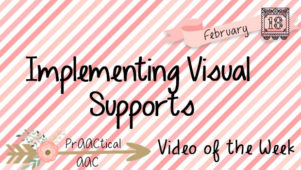
Visual supports are a standard of care for supporting people with autism at home, in school, at work, and in the community. Today, we hear from Laura Ferguson of the Kentucky Autism Training Center on this topic. If you work with teams who are interested in using visual supports and video modeling but could use some help in implementing them effectively, this is a good video to watch. Many thanks to Laura and the Kentucky Autism Training Center for making and sharing this video. You can see a previous video from this series here. Direct Link to Video: https://www.youtube.com/watch?v=fAi1TZP69-I
January 24, 2018
by Carole Zangari -
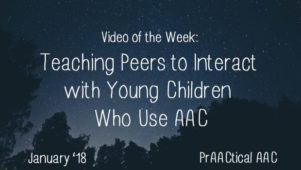
Today, we focus on mobilizing the power of peers. Let’s take a look at some videos that are part of Vanderbilt University’s Evidence-based Practices for Young Children with Autism and Other Disabilities website. Session 1 Session 2
January 22, 2018
by Carole Zangari -
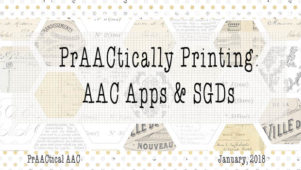
Whether you are working with a traditional SGD or an AAC app, chances are, you want to print a ‘no tech’ version for modeling and/or as a backup communication aid. We’ve shared printable communication boards and books on many previous occasions but here are links to some of the ones that are requested most frequently. Proloquo2Go Crescendo (English, Spanish, French, & Dutch) Snap + Core First (multiple sizes/layouts) and editable copies via Boardmaker Online LAMP Words for Life WordPower (many versions: regular and poster; some Spanish) Unity (with free PASS software) Speak for Yourself Core Samples Do you print and use other manual communication boards or posters? We’d love to hear about that.
December 24, 2017
by Carole Zangari -
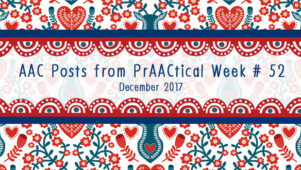
Happy holidays, everyone! Monday – AACtual Therapy: Making Core Words Fun for Students with Autism Wednesday – Video of the Week: Chat with Me in AAC Thursday – An AAC Christmas Carol
December 13, 2017
by Carole Zangari -
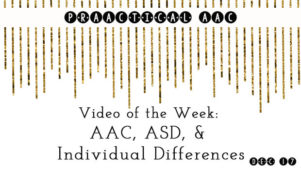
When you’ve worked with one person with autism, the saying goes, you’ve worked with one person with autism. It shouldn’t surprise us, then, that this diversity shows up in research data as well. In this presentation, we hear from Dr. David Trembath, from Griffith University in Australia, explores the individual differences in AAC research and discusses their implications. Many thanks to the Centre for Interdisciplinary Research and Collaboration in Autism (CIRCA) at the University of British Columbia, for making this video available. Direct link to video – https://www.youtube.com/watch?v=TvZ-XH6SLVU
December 9, 2017
by Carole Zangari -
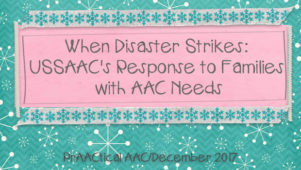
I’m honored to have AAC pioneer Dr. Sarah Blackstone join us today for a guest post that highlights the work that is being done by the US chapter of the International AAC Society (ISAAC). The US chapter, known as USSAAC, has a long-standing commitment to supporting the AAC community in times of national disaster. Dr. Blackstone is both a past president of ISAAC and a founding member of USSAAC. She has authored many AAC-related texts and articles and is a partner emerita of the Rehabilitation Engineering Research Center on Communication Enhancement. She has served the AAC community with distinction, having been granted honors and awards by ASHA, ISAAC, USSAAC, and other organizations. Dr. Blackstone previously practiced at Johns Hopkins Medical Center in Baltimore, and in a private practice that serving children with AAC needs. Currently, Dr. Blackstone is on USSAAC’s Board of Directors. She and Harvey Pressman co-chair USSAAC’s AAC Disaster... [Read More...]
December 4, 2017
by Carole Zangari -
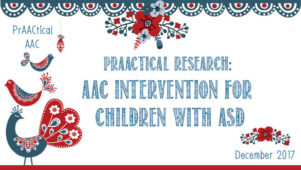
Dr. Kathy Howery is back with another helpful post an AAC research. Kathy is based in Alberta, Canada, and has worked in the field of AT and special education for over three decades. In the past year, she completed her doctoral studies where she used phenomenological methods to seek to understand the lived experience of speaking with/through a speech generating device. Kathy is currently working as a consultant to schools and school districts across Alberta focusing primarily on children and youth with complex communication needs. In this article, she discusses research on AAC interventions. Enjoy! ::::::::::::::::::::::::::::::::::::::::::::::::::::::::::::::::::::::::::::::::::::::::::::: Almirall, D. , DiStefano, C., Chang, Y.-C., Shire, S., Kaiser, A., Lu X, Nahum-Shani, I., Landa, R., Mathy, P. & Kasari, C. (2016). Longitudinal Effects of Adaptive Interventions with a Speech-Generating Device in Minimally Verbal Children with ASD. Journal of Clinical Child & Adolescent Psychology, 45(4), 442-456. What this article is all about (the focus... [Read More...]
November 2, 2017
by Carole Zangari -
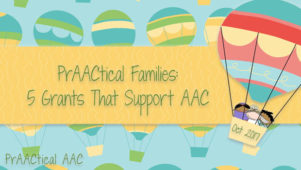
Unless you have a family member with a disability, it’s hard to really understand the toll that specialized services and equipment take on their financial well-being. We’re always on the look-out for sources of support that can help these families. This is the first in a periodic series of posts that list some of the AAC-friendly grant resources open to individual families and clients. The plan is to grow this list and update it with new information, so please comment or email me through the blog if you know of other opportunities. Help is particularly needed for those outside the US. Here are a handful of grants that are AAC-friendly to get us started. CASANA: The iPads for Apraxia program funds iPads for children with apraxia in the US and Canada Small Steps in Speech: Funds supplemental therapies and provides some support to nonprofit organizations who serve very young kids with... [Read More...]
November 1, 2017
by Carole Zangari -
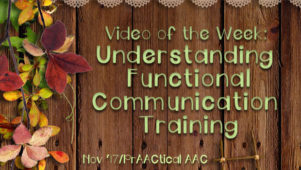
In most special education settings here in the US, professionals recognize the relationship between problem behavior and communication. For the most part, we’ve gotten better at acknowledging that when people hit, yell, flop to the ground, or throw materials, there’s a reason for their behavior. And many times, the behavior is a means of communicating. How do we determine what the communicative function is? How can we help the person communicate in safer, more effective ways? In today’s featured video, Laura Ferguson, of the Kentucky Autism Training Center at the University of Louisville, addresses these questions. Direct link to video: https://www.youtube.com/watch?v=-S7eIRvvoL0&list=PL2_i8EyveJe_UNsVzunszW3-Y3dEplws3
October 26, 2017
by Carole Zangari -
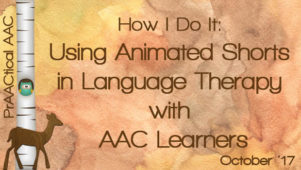
Looking for ways to engage AAC learners in language therapy? Today, we welcome back SLP Rachel Madel to tell us about her experience in using wordless videos. Her prAACtical tips will get you excited about using videos like these, curated by The Activity Tailor, in your lessons. Enjoy! ::::::::::::::::::::::::::::::::::::::::::::::::::::::::::::::::::::::::::::::: Using Animated Shorts to Build Language Skills with AAC Learners We are living in a digital age, where video content is often free and easy to access. Children on my caseload are tech savvy and are constantly dazzling me with how well they can navigate YouTube to find their favorite videos. Motivation is paramount in creating meaningful communication interactions and watching animated videos is highly motivating for both students and clinicians. I’ve had great success utilizing wordless videos in my practice and was lucky enough to present on the topic during “AAC After Work” with a fellow AAC colleague, Susan Berkowitz. In case... [Read More...]









